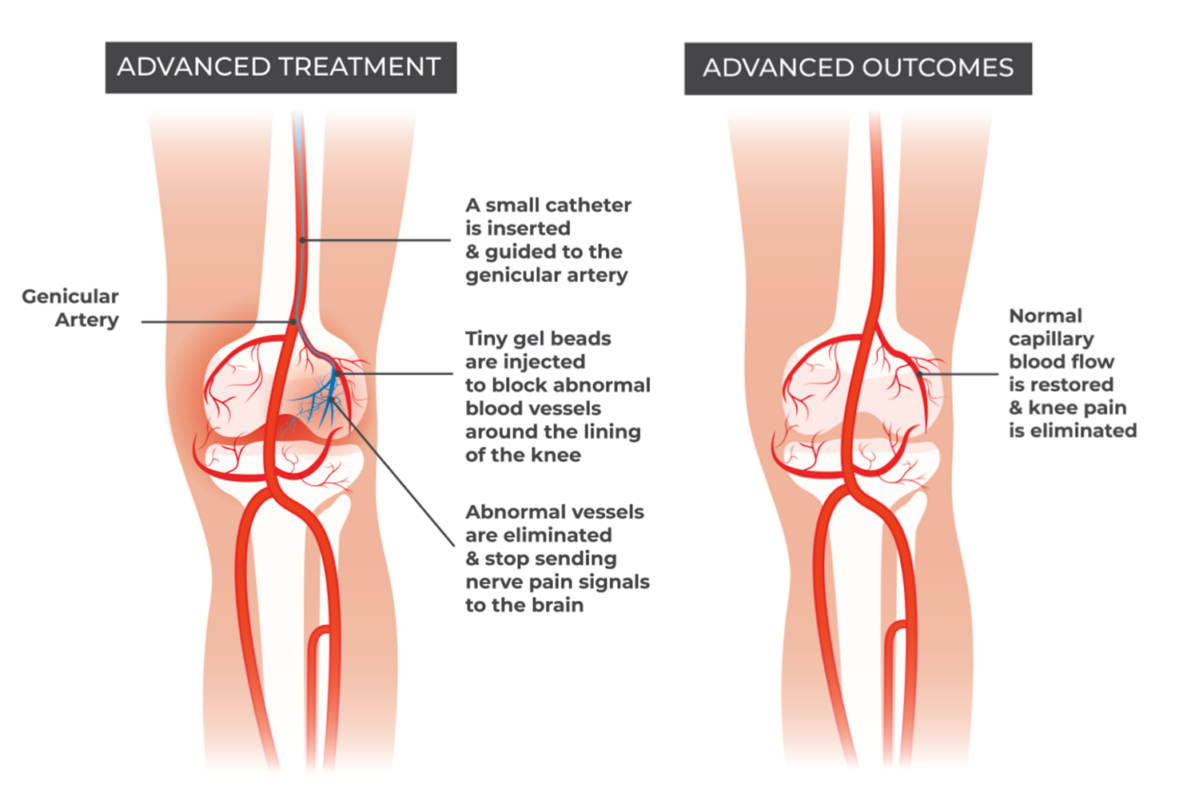What is Genicular Artery Embolization (GAE)?
Genicular Artery Embolization (GAE) is an innovative, minimally invasive procedure used to treat chronic knee pain, particularly caused by osteoarthritis. This cutting-edge treatment involves blocking specific blood vessels—called genicular arteries—that supply blood to the inflamed areas of the knee. By reducing blood flow, GAE helps lower inflammation, which can significantly reduce pain levels and improve mobility for patients.
At Flowcare, we specialize in advanced procedures like GAE, offering patients a safer and effective alternative to more invasive surgeries such as total knee replacement.
Who Can Benefit from GAE?
GAE is primarily targeted at patients suffering from chronic knee pain caused by osteoarthritis, but it can also benefit individuals with other causes of knee inflammation. It is especially ideal for those who:
- Have moderate to severe knee pain
- Are unresponsive to conservative treatments like physical therapy, medications, or injections
- Want to avoid or delay knee replacement surgery
- Are not suitable candidates for surgery due to age or other health conditions
Flowcare’s team of experts assesses each patient’s specific condition to determine if they are a good candidate for GAE. We pride ourselves on offering a personalized, comprehensive approach to pain management.
The GAE Procedure: What to Expect
GAE is a non-surgical procedure performed under local anesthesia. It is typically done on an outpatient basis, which means patients can return home the same day. The procedure takes approximately 1-2 hours, depending on the individual case.
Here’s a step-by-step breakdown of how GAE is performed:
- Local Anesthesia: The patient is given local anesthesia to numb the area around the groin, where a small catheter will be inserted.
- Catheter Insertion: A small incision is made in the groin, and a catheter is carefully guided to the genicular arteries in the knee.
- Embolization: Tiny particles are injected through the catheter to block the blood flow in the targeted arteries. This reduces inflammation in the knee and leads to a significant reduction in pain.
- Post-Procedure Care: After the procedure, the catheter is removed, and the incision is bandaged. The patient is typically monitored for a few hours before being discharged.
Flowcare ensures that every patient undergoing GAE is monitored closely, with follow-up care to ensure optimal recovery and results.
Benefits of Genicular Artery Embolization
GAE offers several key advantages over traditional surgical options:
- Minimally Invasive: GAE is performed without the need for large incisions or extensive surgery. This means less pain, faster recovery, and fewer complications for patients.
- Short Recovery Time: Patients undergoing GAE typically experience shorter recovery periods compared to those who opt for surgical treatments. Many return to normal activities within a few days, with improved mobility and significantly reduced pain.
- Effective Pain Relief: Studies have shown that GAE is highly effective in reducing knee pain, especially in patients with osteoarthritis. By targeting the blood vessels directly involved in inflammation, this procedure can provide long-term pain relief.
- Avoid or Delay Surgery: GAE is an excellent option for those looking to avoid or delay knee replacement surgery. For many patients, this procedure can offer relief for months or even years, reducing the need for invasive surgery.
- Minimal Risk: Since GAE is a minimally invasive procedure, it has fewer risks compared to traditional surgery. There is no need for general anesthesia, and the likelihood of complications is significantly lower.
At Flowcare, we ensure that our patients understand both the benefits and risks of any procedure, offering informed consent and detailed consultations.
Risks and Side Effects
Like any medical procedure, GAE comes with some risks, though they are minimal. Common side effects may include:
- Mild bruising or swelling at the catheter insertion site
- Temporary pain in the treated knee as the body adapts to the changes in blood flow
- Rarely, there may be an infection at the catheter site or unintended blockage of other blood vessels
However, with Flowcare’s experienced team, these risks are minimized through careful planning, imaging, and the use of state-of-the-art equipment.
Why Choose Flowcare for Genicular Artery Embolization?
Flowcare is a leader in providing minimally invasive solutions for chronic pain, including Genicular Artery Embolization. Our medical team has extensive experience in interventional radiology and pain management, ensuring that patients receive the best possible care with cutting-edge technology.
Here’s why Flowcare is the trusted choice for GAE:
- Expertise: Our specialists are trained in the latest techniques in GAE, ensuring you receive the highest standard of care.
- Patient-Centered Approach: We offer personalized treatment plans tailored to each patient’s specific needs.
- Safety and Comfort: With a focus on patient safety and comfort, Flowcare provides a relaxed environment for your procedure and recovery.
- Comprehensive Care: From initial consultations to follow-up care, Flowcare supports patients at every step of their treatment journey.
Conclusion
Genicular Artery Embolization is a game-changer for individuals suffering from chronic knee pain, particularly osteoarthritis. Offering a minimally invasive, effective, and safe alternative to surgery, GAE has the potential to restore mobility and improve the quality of life for many patients. Flowcare’s expert team is dedicated to providing top-notch care and ensuring the best possible outcomes for all patients undergoing this innovative procedure.




